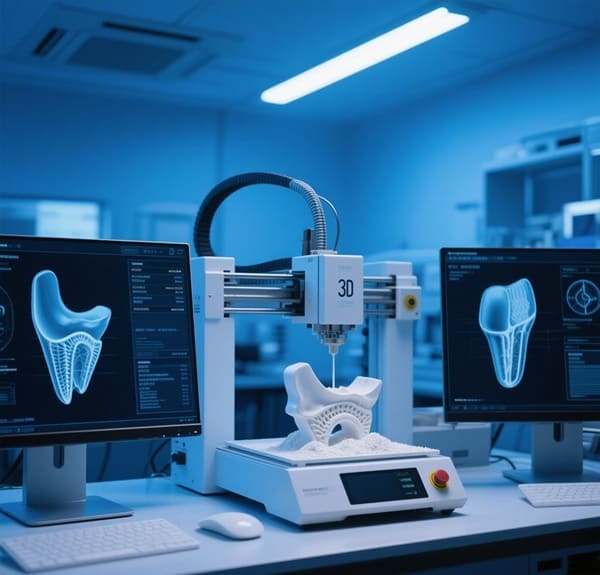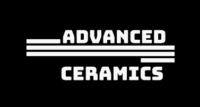Avantages de l'impression 3D dans le domaine de la céramique
L'impression 3D de céramiques s'est imposée comme une technologie transformatrice dans le domaine des matériaux avancés. Combinant les avantages de la fabrication additive et les propriétés uniques de la céramique, ce processus permet la production de pièces complexes, le prototypage rapide et des composants personnalisés qui sont difficiles, voire impossibles à produire avec des méthodes traditionnelles. Alors que la demande de pièces en céramique de haute performance augmente dans des secteurs tels que l'aérospatiale, le biomédical et l'électronique, l'impression 3D offre une flexibilité de conception inégalée, une rentabilité pour les petits lots et des délais de livraison réduits. Cet article explore la manière dont l'impression 3D révolutionne la fabrication de céramiques, les technologies impliquées, les matériaux adaptés à la fabrication additive, les avantages comparatifs par rapport aux processus conventionnels et les perspectives d'avenir de cette approche innovante..
Au Moyeu en céramique avancéeNous sommes spécialisés dans diverses céramiques, garantissant des performances optimales pour les applications industrielles et scientifiques.

Qu'est-ce que l'impression 3D et comment fonctionne-t-elle dans le domaine de la céramique ?
L'impression 3D, également connue sous le nom de fabrication additive, permet de construire des objets couche par couche à partir d'un fichier numérique. Dans les applications céramiques, des matériaux tels que des pâtes, des boues ou des poudres sont déposés à l'aide de technologies telles que la stéréolithographie (SLA), le traitement numérique de la lumière (DLP), la projection de liant et le robocasting.
Comparaison des technologies d'impression 3D de céramiques :
| Technologie | Méthode de formage | Forme matérielle | Résolution | Applications courantes |
| SLA/DLP | Photopolymérisation | Boue céramique | Haut | Dentaire, microstructures |
| Jetting de liant | Application du liant | Poudre céramique | Moyen | Composants industriels |
| Robocasting | Extrusion | Pâte céramique | Moyen | Parties structurelles et poreuses |
Quels sont les principaux avantages de l'impression 3D en tant que méthode de fabrication ?
L'impression 3D offre des avantages qui vont au-delà des processus soustractifs ou de moulage traditionnels. Sa flexibilité et sa nature numérique en font une option rentable pour les composants complexes et personnalisés.
Principaux avantages de l'impression 3D :
- Cycles de prototypage rapides
- Pas besoin d'outillage ni de moules
- Permet des géométries complexes et organiques
- Convient pour les pièces personnalisées de faible volume
Comment fonctionne le processus d'impression 3D de céramiques, étape par étape ?
L'impression 3D de céramiques comprend plusieurs étapes critiques, de la conception initiale au frittage. Chaque phase joue un rôle crucial dans la détermination de la qualité et des performances finales de la pièce en céramique. Il est essentiel de gérer correctement les paramètres tels que la température, l'humidité et la teneur en liant pour éviter les fissures, le gauchissement ou le rétrécissement. Vous trouverez ci-dessous un flux de travail typique utilisé dans les différentes technologies d'impression 3D de céramiques.
Flux de travail typique de l'impression 3D de céramiques :
| Étape | Description | Paramètres clés | Exigée |
| Modélisation CAO | Conception 3D de la pièce | Précision, complexité | Oui |
| Impression | Dépôt de matériaux | Température, vitesse | Oui |
| Débouclage | Retrait des classeurs | 300-600°C | Cela dépend |
| Frittage | Densification de la céramique | 1200-1700°C | Oui |
| Post-traitement | Finition de surface | Polissage, meulage | En option |
Pourquoi l'impression 3D est-elle particulièrement adaptée aux céramiques ?
Les céramiques sont dures, cassantes et difficiles à usiner, ce qui rend la fabrication traditionnelle à la fois complexe et coûteuse. L'impression 3D permet de relever ces défis grâce à une mise en forme proche de la forme nette, en minimisant les contraintes mécaniques et en éliminant le besoin de moules. Il en résulte des cycles de développement plus rapides, moins de défauts et une production rentable de prototypes ou de petites séries.
Défis de la fabrication traditionnelle de céramiques par rapport aux solutions d'impression 3D :
| Défi traditionnel | L'avantage de l'impression 3D |
| Coût élevé de l'outillage et du moule | Aucun moule n'est nécessaire - conception numérique directe |
| Matériaux fragiles difficiles à façonner | Dépôt doux, couche par couche |
| Capacités géométriques limitées | Liberté de concevoir des structures complexes |
| Longs délais de production | Fabrication numérique rapide |
| Risque de fissures de tension internes | Manipulation et contraintes mécaniques minimales |
L'impression 3D permet aux ingénieurs de débloquer des applications céramiques dont le coût était auparavant prohibitif ou techniquement irréalisable avec les techniques conventionnelles.
Quels matériaux céramiques conviennent le mieux à l'impression 3D ?
Toutes les céramiques ne se comportent pas de la même manière dans l'impression 3D. Certains matériaux sont plus compatibles en raison de leur distribution granulométrique, de leur comportement de frittage et de la façon dont ils interagissent avec les liants et les processus d'enlèvement des supports. Les céramiques les plus performantes ont généralement des particules fines et uniformes qui améliorent la fluidité et la densité de l'emballage pendant l'impression. Les matériaux présentant une grande stabilité thermique et des profils de retrait prévisibles sont particulièrement appréciés car ils garantissent la précision des dimensions après le frittage. En outre, le choix du matériau dépend souvent de l'application - par exemple, les biocéramiques comme l'hydroxyapatite conviennent aux implants, tandis que la zircone est utilisée lorsque la résistance mécanique est essentielle.
Comparaison des performances des matériaux céramiques imprimables en 3D :
| Matériau | Point de fusion (°C) | Résistance (MPa) | Applications typiques |
| Alumine (Al2O3) | 2050 | 300-500 | Isolants électriques, substrats |
| Zircone (ZrO2) | 2700 | 900-1200 | Implants médicaux, outils de coupe |
| Nitrure de silicium | 1900 | 700-1000 | Roulements, composants du moteur |
| Hydroxyapatite | N/A | Modéré | Biomédical (prothèses osseuses) |
Ces matériaux sont couramment utilisés parce qu'ils offrent un équilibre entre les performances, l'imprimabilité et la disponibilité. Chacun possède des caractéristiques distinctes qui correspondent à des besoins d'utilisation finale spécifiques, et les recherches en cours continuent d'élargir la gamme des céramiques imprimables.
Découvrez nos matériaux céramiques de haute qualité
Quels sont les avantages spécifiques de l'impression 3D pour les céramiques ?
Appliquée à la céramique, l'impression 3D offre des possibilités inégalées, notamment en termes de précision, de complexité et d'efficacité des matériaux.
Avantages de l'impression 3D de céramiques :
- Formes complexes monoblocs
- Microcaractéristiques à haute résolution
- Déchets minimaux de matériaux
- Structures poreuses pour biocéramiques
Comment l'impression 3D de céramiques se compare-t-elle aux méthodes de fabrication traditionnelles ?
Par rapport aux techniques conventionnelles telles que la coulée en barbotine ou le pressage isostatique, l'impression 3D est plus souple et souvent plus économique pour les petites séries ou les pièces complexes.
Tableau de comparaison : Impression 3D et méthodes traditionnelles
| Fonctionnalité | Impression 3D | Coulée en dérapage | Pressage isostatique | Pressage à chaud |
| Flexibilité de la conception | Haut | Faible | Faible | Moyen |
| Coût de l'outillage | Faible | Moyen | Haut | Haut |
| Précision | Haut | Moyen | Haut | Haut |
| Vitesse de production | Rapide | Lenteur | Lenteur | Moyen |
Quel est l'avenir de l'impression 3D de céramiques ?
L'avenir de l'impression 3D de céramiques est prometteur, les innovations conduisant à une adoption accrue dans tous les secteurs. À mesure que l'équipement devient plus abordable et que les matériaux sont conçus pour de meilleures performances, la technologie passera du prototypage à la production à grande échelle. Les progrès en matière d'automatisation, d'apprentissage automatique et de systèmes de fabrication hybrides permettront de rationaliser davantage les flux de travail et d'améliorer la répétabilité. En outre, les systèmes multi-matériaux et les formulations nano-céramiques permettent de nouvelles applications dans les secteurs biomédical, aérospatial et électronique.
Tendances émergentes :
- Impression céramique multi-matériaux
- Matières premières à moindre coût
- Systèmes de frittage compacts
- Intégration avec le post-traitement CNC
- Utilisation croissante dans les domaines de l'aérospatiale et de la médecine
Demandez un devis personnalisé pour des matériaux céramiques de haute qualité.
FAQ
| Question | Réponse |
| Quelle est la résolution typique de l'impression 3D de céramiques ? | Gammes de ±20-50μm ; les imprimantes haut de gamme peuvent atteindre ±10μm, ce qui permet d'obtenir des caractéristiques finement détaillées. |
| Quelle est la meilleure technologie pour l'impression céramique ? | La technologie DLP et le moulage par robot sont privilégiés pour leur précision, la polyvalence des matériaux et la qualité de la surface. |
| Le rétrécissement est-il un problème dans l'impression 3D de céramiques ? | Oui, le retrait du 15-25% pendant le frittage est courant et doit être compensé lors de la conception. |
| Combien de temps dure le post-traitement après l'impression ? | Le déliantage et le frittage peuvent durer de quelques heures à 24 heures en fonction du matériau et de la taille de la pièce. |
| Les pièces en céramique imprimées en 3D sont-elles aussi résistantes que celles fabriquées traditionnellement ? | En général, la densité et la résistance sont légèrement inférieures, mais des progrès constants permettent de combler l'écart. |
Conclusion
L'impression 3D de céramiques comble le fossé entre la liberté de conception et les exigences en matière de matériaux de haute performance. Grâce à son adoption croissante dans les industries de haute technologie et aux améliorations constantes apportées aux équipements et aux matériaux, elle est sur le point de redéfinir la fabrication des céramiques.
Advanced Ceramic Hub fournit des matériaux d'impression 3D en céramique avancée et des solutions techniques pour soutenir votre innovation dans les applications médicales, aérospatiales et électroniques.
Vous recherchez des céramiques de haute qualité ? Contactez-nous dès aujourd'hui !
